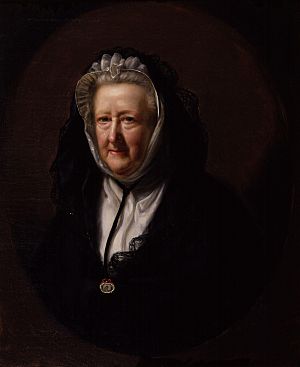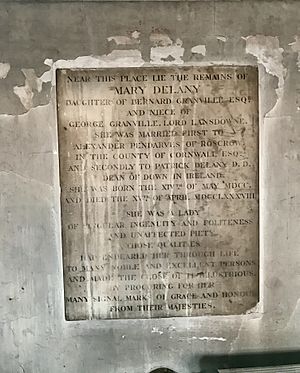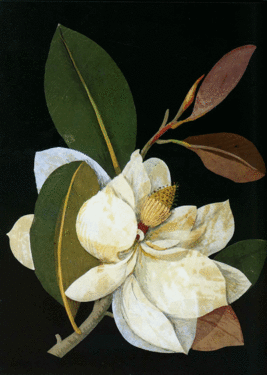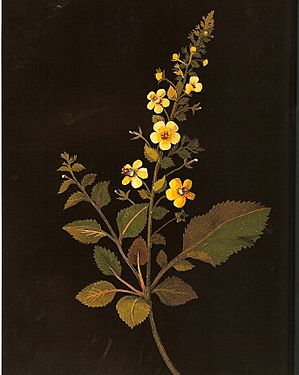Mary Delany facts for kids
Quick facts for kids
Mary Delany
|
|
|---|---|

Portrait by John Opie, 1782.
|
|
| Born |
Mary Granville
14 May 1700 Coulston, Wiltshire, England
|
| Died | 15 April 1788 (aged 87) |
| Known for | paper-cutting, decoupage |
Mary Delany (born Mary Granville) was an amazing English artist, writer, and a member of the "Blue Stockings Society." She was famous for her unique "paper-mosaicks," which were detailed paper cut-outs of plants. She also loved botanic drawing, needlework, and writing many interesting letters. Mary lived from May 14, 1700, to April 15, 1788.
Contents
Mary's Early Life
Mary Delany was born in Coulston, Wiltshire, England. Her father was Colonel Bernard Granville, and her mother was Mary Westcombe. Her family supported the King and Queen at the time. Mary had an older brother named Bernard, a younger brother named Bevil, and a sister named Anne.
When Mary was young, her family moved to London. She went to a school run by a French teacher, Mademoiselle Puelle. Mary also spent time living with her aunt, Lady Stanley. Her aunt wanted Mary to become a Maid of Honour at the royal court.
While living with Lady Stanley, Mary learned many things. She studied English, French, history, music, needlework, and dancing. She also met the famous composer Handel there. Mary loved his music and remained his close friend and supporter throughout her life.
Mary's dream of working for the Queen changed when Queen Anne died in 1714. A new royal family came to power, and Mary's family moved to a quiet manor in Buckland, Gloucestershire. Even though they were away from city life, Mary continued her education. She also kept practicing her paper cutting, a hobby she had enjoyed since she was very young.
In late 1717, Mary visited her uncle, George Granville, 1st Baron Lansdowne. There, she met Alexander Pendarves. Her family soon showed interest in Mary marrying him. Mr. Pendarves was a Member of Parliament and 60 years old, while Mary was only 17. In February 1718, she married him, even though she was not happy about it. This marriage happened because her parents needed financial help from her uncle.
Life as a Married Woman
After their wedding, the Pendarveses moved to Roscrow Castle in Cornwall. Mary enjoyed the beautiful views and spent time riding horses. However, Mr. Pendarves's health got worse. Mary had to spend her time caring for him and doing needlework or painting flowers.
In 1721, they moved to a house in London. Mary was happy to see her old friends again. In 1725, Mr. Pendarves died suddenly. He had not changed his will after they married, so Mary did not inherit his money.
Even without much money, being a widow gave Mary new chances. Widows could move around in society more freely than unmarried women. For the first time, Mary could follow her own interests without a man telling her what to do. She felt strongly that women should marry by choice, not because they had to. She wrote, "Why must women be driven to the necessity of marrying? a state that should always be a matter of choice!"
Mary was a very smart and observant woman. She judged people and things for herself. She loved learning new things throughout her life.
Since she didn't have her own home, Mary lived with different relatives and friends after her first husband died. She stayed with her aunt and uncle Stanley. Later, she visited Ireland with her friend Mrs. Donellan's family. In Ireland, Mary met Dr. Patrick Delany, an Irish clergyman. He was already married at the time.
In 1743, two years after his first wife passed away, Dr. Delany proposed to Mary during a trip to London. Her family was not happy about this. But they got married in June 1743.
The Delanys lived in London for a year before moving to Dr. Delany's home in Dublin, Ireland. They also rented a house called Mount Panther in County Down. Both Mary and Patrick loved botany and gardening. They enjoyed their garden at Delville near Dublin very much. Patrick encouraged Mary in her gardening, painting, shell-work, and needlework. This led to her creating many artworks, mostly featuring flowers.
After 25 years of marriage, Dr. Delany died in Bath, England, in 1768. Mary was 68 years old and a widow once more.
Later Years and Artistic Career
As a widow, Mary Delany spent even more time at Bulstrode, the home of her close friend, Margaret Bentinck, Dowager Duchess of Portland. They both loved botany and often went looking for special plants together. While staying at Bulstrode, Mary met two famous botanists: Joseph Banks and Daniel Solander. Meeting them made Mary even more interested in botany. This knowledge helped her create her amazing flower paper-cuttings.
Mary Delany had always been an artist. But during her marriage to Dr. Delany, she had more time to improve her skills. She was also a gardener, and she did needlework, drawing, and painting. But she became most famous for her unique paper-cutting art.
Her "mosaicks" were made from colored paper. She used different shades and colors to show all the details and light effects of a plant. She also became friends with Letitia Bushe, another artist, and they worked on many art projects together.
In 1771, when Mary was in her early 70s, she started making her famous paper collages, also called decoupage. These artworks were very detailed and looked exactly like real plants. She used thin tissue paper and colored it by hand. From age 71 to 88, she created 985 of these "Paper Mosaiks" until her eyesight failed her.
To make these, she would place a real plant in front of her. Then, she would cut tiny pieces of colored paper to look like the petals, leaves, stems, and other parts of the plant. She used lighter and darker paper to create shadows. She would sometimes layer many pieces of paper, and one plant picture could have hundreds of pieces! It's thought she would first carefully take apart each plant to study it closely.
Mary became very well-known, and people started sending her flowers to use in her art. You can see her work in the Enlightenment Gallery at the British Museum. After she died, her ten volumes of Flora Delanica (her collection of paper flowers) were given to the British Museum.
When her friend, the Dowager Duchess, died, King George III and Queen Charlotte gave Mary a small house in Windsor and a yearly payment. Mary became good friends with Queen Charlotte while living there. She became an important part of the royal court, teaching the young princes and princesses about plants and sewing. The King and Queen were big fans of her work. They even said that any interesting or beautiful plants should be sent to Mrs. Delany when they bloomed.
By the 1780s, Mary also knew Georgiana Cavendish, Duchess of Devonshire and Frances Burney. She often visited them in London and Windsor. Mary had met many important people of her time. She wrote letters to famous figures like Jonathan Swift and Sir Joseph Banks. Her six volumes of Autobiography and Letters give a detailed look at polite English society in the 1700s.
Mary Delany passed away on April 15, 1788. There is a memorial for her in St James's Church, Piccadilly.
Mary's Legacy
The Ulster Museum in Belfast has an embroidered bedcover made by Mrs. Delany. It is one of the few complete pieces of her needlework that still exists. Her letters describe other embroidered items, including pieces with violets, poppies, and lilies. She also richly embroidered her own clothes. For example, she made a ballgown for a royal birthday in 1751, decorated with pinks, lily of the valley, and other flowers, all shown in accurate detail.
In 1980, Ruth Hayden, a descendant of Mary's sister Anne, wrote a book about Mary's art called Mrs. Delany and Her Flower Collages. It was reissued in 2000 as Mrs. Delany: Her Life and Her Flowers. A new biography about Mary Delany was published in 2019.
In the 1980s, Irish fashion designer Sybil Connolly created a line of tableware for Tiffany & Co. inspired by Mrs. Delany's flower collages.
In 2022, a type of rose called 'Mortimer Sackler' was renamed 'Mary Delany' by David Austin Roses to honor the artist.
Gallery







